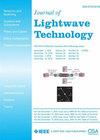Efficient and Reconfigurable Soliton Microcomb Source Based on the 400-nm-Thick Si3N4 Platform
IF 4.1
1区 工程技术
Q2 ENGINEERING, ELECTRICAL & ELECTRONIC
引用次数: 0
Abstract
Dark soliton microcombs with a high repetition rate and high line power can be generated in a nonlinear ring with normal group velocity dispersion (GVD), making them suitable for various applications. This study explores the impact of pump power, coupling coefficient, waveguide loss, and GVD on the dark soliton spectral profile, including the power level of the comb lines and the extent of the flat spectral range. A dark soliton microcomb is experimentally generated based on a 400-nm-thick Si3N4 microring, demonstrating an off-chip −10-dBm bandwidth of 28 nm. Spectral reconstruction of the efficient dark soliton is also achieved. By changing the temperature by 2 °C, the −10-dBm bandwidth is varied from 23 nm to 28 nm and the spectral flatness is modified. Furthermore, the comb spacing of the generated dark soliton can be changed from one free spectral range (FSR) to three FSRs by properly adjusting the pump power and wavelength. The proposed scheme offers a straightforward method for creating an efficient soliton microcomb source with a customizable spectral shape on the 400-nm-thick Si3N4 platform, suitable for a variety of applications.求助全文
约1分钟内获得全文
求助全文
来源期刊

Journal of Lightwave Technology
工程技术-工程:电子与电气
CiteScore
9.40
自引率
14.90%
发文量
936
审稿时长
3.9 months
期刊介绍:
The Journal of Lightwave Technology is comprised of original contributions, both regular papers and letters, covering work in all aspects of optical guided-wave science, technology, and engineering. Manuscripts are solicited which report original theoretical and/or experimental results which advance the technological base of guided-wave technology. Tutorial and review papers are by invitation only. Topics of interest include the following: fiber and cable technologies, active and passive guided-wave componentry (light sources, detectors, repeaters, switches, fiber sensors, etc.); integrated optics and optoelectronics; and systems, subsystems, new applications and unique field trials. System oriented manuscripts should be concerned with systems which perform a function not previously available, out-perform previously established systems, or represent enhancements in the state of the art in general.
 求助内容:
求助内容: 应助结果提醒方式:
应助结果提醒方式:


